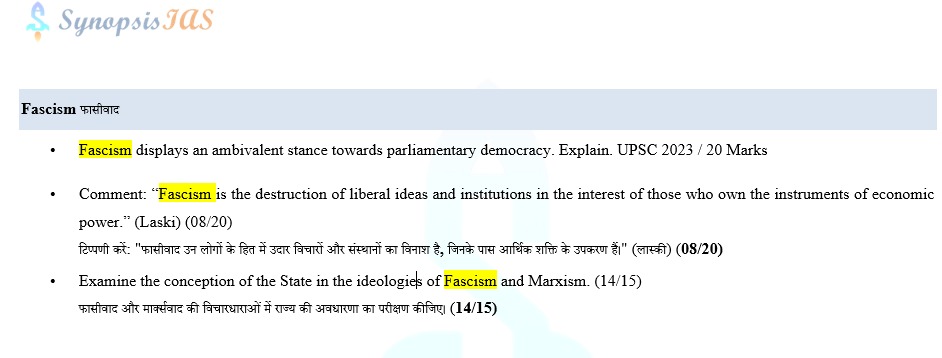PSIR 3a. Fascism displays an ambivalent stance towards parliamentary democracy. Explain. UPSC 2023 / 20 Marks
Fascism's ambivalent stance towards parliamentary democracy becomes evident through its simultaneous co-optation and subversion of democratic institutions and values. While fascists may employ democratic elements to gain power, they subsequently erode these elements to establish authoritarian rule. This complex relationship highlights the incompatibility between fascism and the principles of liberal democracy.
This article is part of Synopsis IAS Political Science and International Relations (PSIR) Optional Course.

Introduction:
Fascism, as an authoritarian ideology and political system, displays a complex and ambivalent relationship with parliamentary democracy. While it shares some superficial elements with democracy, its core principles and actions often undermine the foundations of liberal democracy.
Fascism's View on Democracy:
Fascism's stance on parliamentary democracy can be understood through various perspectives:
1. Opposition to Pluralism:
Fascism rejects the idea of pluralism, which is central to democracy. It advocates for a single-party system and suppresses opposition parties, curtailing political diversity and debate.
2. Leader-Centric Governance:
Fascist regimes are often characterized by a charismatic leader who concentrates power in their hands. This concentration of power contradicts the principles of democracy, where power is dispersed among multiple institutions and actors.
3. Suppression of Political Opposition:
Fascist regimes frequently employ violence and coercion to eliminate political opponents, including dissidents, activists, and rival parties. This suppression is antithetical to the democratic values of free speech and political competition.
4. Manipulation of Elections:
While fascist regimes may hold elections, these are often manipulated to ensure the victory of the ruling party or leader. The presence of a single, controlled party limits genuine electoral choice.
5. Erosion of Civil Liberties:
Fascist governments tend to curtail civil liberties, including freedom of the press, assembly, and association. These restrictions undermine the democratic principles of individual rights and freedoms.
6. Cult of Personality:
Fascist leaders cultivate a cult of personality that elevates the leader to a god-like status. This personality cult diminishes the importance of democratic institutions and values.
7. Subversion of Constitutionalism:
Fascist regimes may employ legal measures to subvert constitutional constraints on power, rendering democratic institutions ineffective in checks and balances.
8. Manipulation of Mass Media:
Fascist governments control and manipulate mass media to disseminate propaganda and suppress dissenting voices, limiting the public's access to diverse and unbiased information.
Conclusion:
Fascism's ambivalent stance towards parliamentary democracy becomes evident through its simultaneous co-optation and subversion of democratic institutions and values. While fascists may employ democratic elements to gain power, they subsequently erode these elements to establish authoritarian rule. This complex relationship highlights the incompatibility between fascism and the principles of liberal democracy.